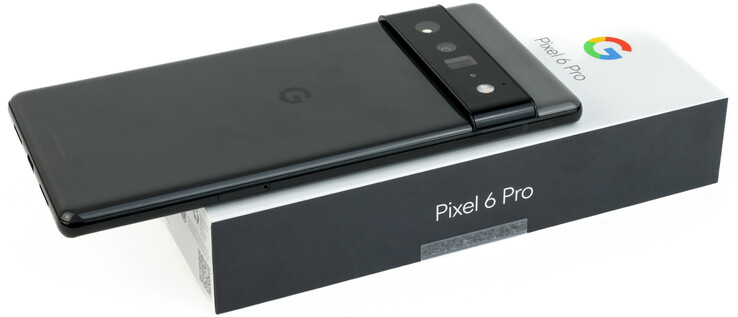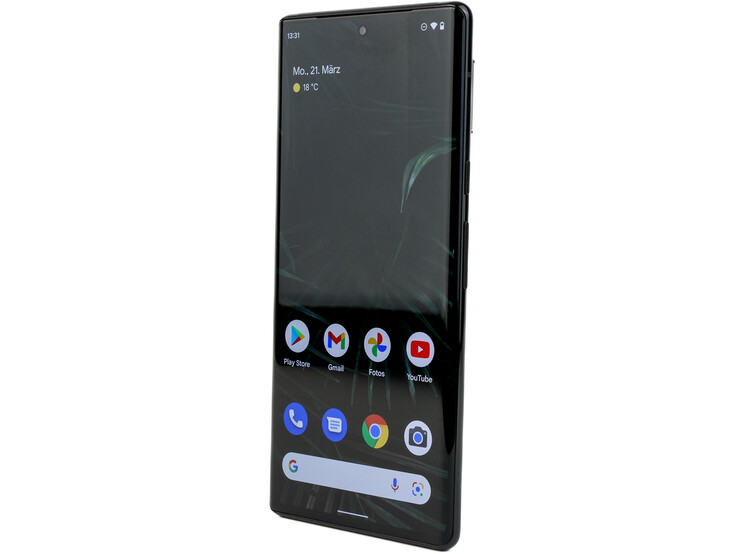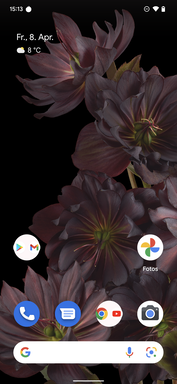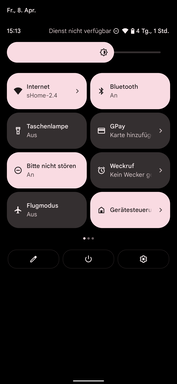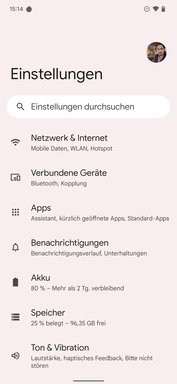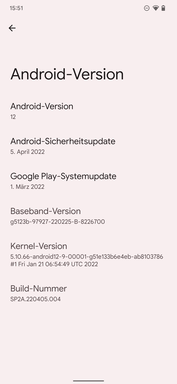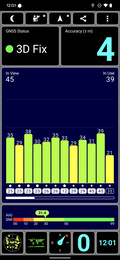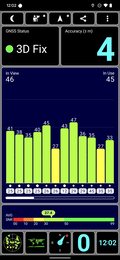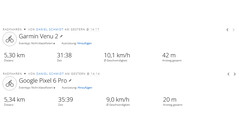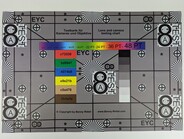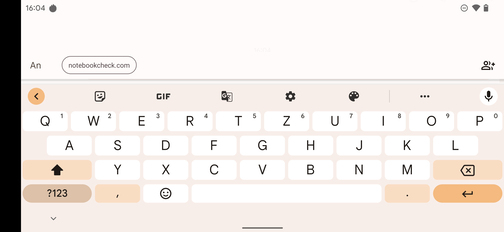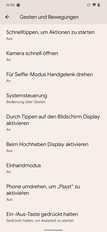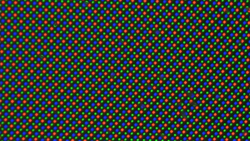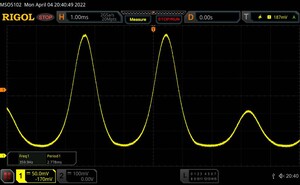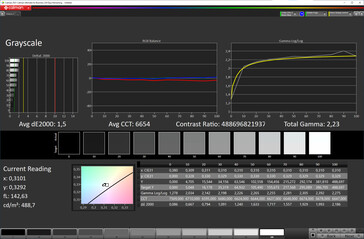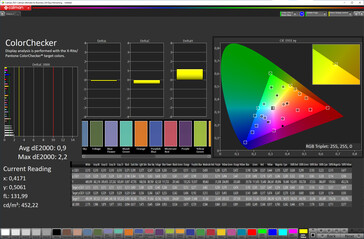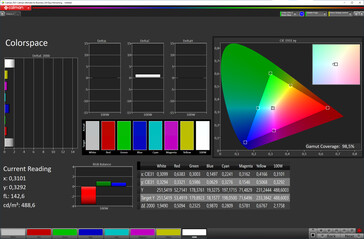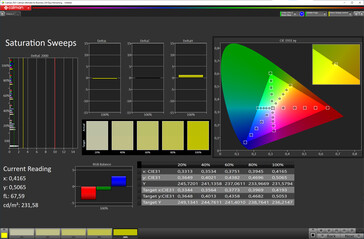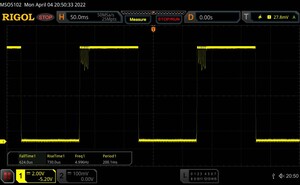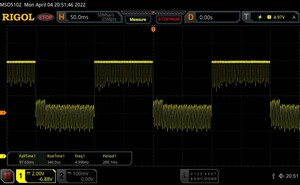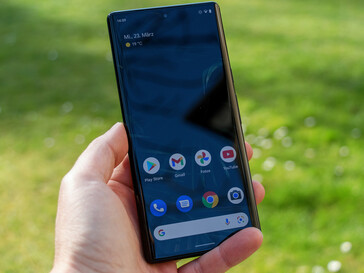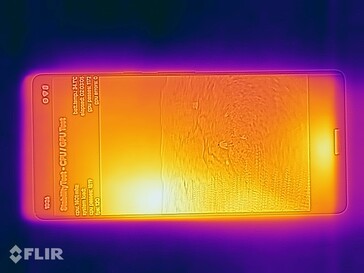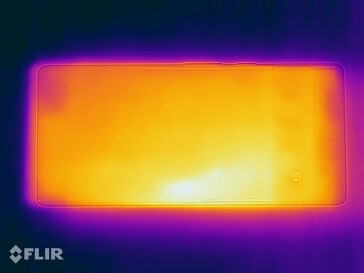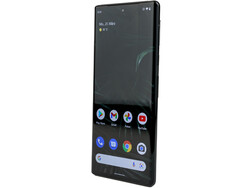Revisão do Google Pixel 6 Pro - Eye Candy com Baunilha Android
O Pixel 6 Pro do Google é o concorrente mais bem equipado do Pixel 6. Ele apresenta uma tela maior com uma resolução maior e uma taxa de atualização mais alta, uma bateria maior e mais RAM. A configuração da câmera parece muito semelhante à primeira vista, mas ao contrário do Pixel 6, o Pixel 6 Pro vem com um zoom óptico
Na Europa, o dispositivo está disponível em dois trims, um com 128 GB e outro com 256 GB de armazenamento a partir de $899 e $999, respectivamente. Os clientes dos EUA também são tratados com uma opção de armazenamento de 512 GB por mais $100.
Possíveis concorrentes em comparação
Avaliação | Data | Modelo | Peso | Unidade | Size | Resolução | Preço |
|---|---|---|---|---|---|---|---|
| 89.2 % v7 (old) | 04/2022 | Google Pixel 6 Pro Tensor, Mali-G78 MP20 | 210 g | 128 GB UFS 3.1 Flash | 6.70" | 3120x1440 | |
| 88.9 % v7 (old) | 05/2022 | Samsung Galaxy S22+ Exynos 2200, Xclipse 920 | 196 g | 128 GB UFS 3.1 Flash | 6.60" | 2340x1080 | |
| 87.6 % v7 (old) | 02/2022 | Xiaomi 12 Pro SD 8 Gen 1, Adreno 730 | 204 g | 256 GB UFS 3.1 Flash | 6.73" | 3200x1440 | |
| 90.8 % v7 (old) | 10/2021 | Apple iPhone 13 Pro A15, A15 GPU 5-Core | 203 g | 256 GB NVMe | 6.10" | 2532x1170 | |
| 89.2 % v7 (old) | 04/2022 | Oppo Find X5 Pro SD 8 Gen 1, Adreno 730 | 221 g | 256 GB UFS 3.1 Flash | 6.70" | 3216x1440 |
Os Top 10
» Os Top 10 Portáteis Multimídia
» Os Top 10 Portáteis de Jogos
» Os Top 10 Portáteis Leves para Jogos
» Os Top 10 Portáteis Acessíveis de Escritório/Empresariais
» Os Top 10 Portáteis Premium de Escritório/Empresariais
» Os Top 10 dos Portáteis Workstation
» Os Top 10 Subportáteis
» Os Top 10 Ultrabooks
» Os Top 10 Conversíveis
» Os Top 10 Tablets
» Os Top 10 Smartphones
» A melhores Telas de Portáteis Analisadas Pela Notebookcheck
» Top 10 dos portáteis abaixo dos 500 Euros da Notebookcheck
» Top 10 dos Portáteis abaixo dos 300 Euros
Estojo - Não muito mais pesado que o Pixel 6
Apesar de sua tela maior e sua bateria maior, o Google Pixel 6 Pro é apenas ligeiramente maior e com um adicional de 3 g (0,1 oz), sempre apenas ligeiramente mais pesado do que o Pixel 6. Devido a sua tela ligeiramente mais estreita e ao vidro curvo ao longo das laterais, também encontramos uma melhor relação tela/corpo de 89 %.
A estrutura metálica de nossa unidade de revisão foi polida e, portanto, tão suscetível a impressões digitais e manchas quanto a Corning Gorilla Glass Victus cobrindo ambos os lados. A qualidade de construção foi boa em geral, com aberturas uniformes e estreitas e apenas pequenos rangidos quando empenadas.
O Google Pixel 6 Pro tem certificação IP68 contra a entrada de poeira e água e está disponível em três cores: Preto tempestuoso, Branco nublado e tipo ensolarado.
Conectividade - Pixel 6 Pro com USB rápido
O Google Pixel 6 Pro apresenta uma rápida porta USB 3.2 Gen 1 para rápidas transferências de dados e USB OTG. Infelizmente, ele não suporta saída de tela com fio. Bluetooth 5.2 e NFC são suportados.
Em geral, o Pixel 6 Pro segue a abordagem minimalista de seu predecessor. Falta-lhe suporte para expansão de armazenamento microSD, um LED de notificação, um blaster IR, um receptor de rádio FM, e muito mais.
Software - Ciclo longo de atualização, incluindo Android 15
O Google Pixel 6 Pro vem com Android 12 por padrão e, como o Pixel 6, um longo ciclo de atualização com um mínimo de três anos de atualizações de características mais dois anos adicionais de atualizações de segurança por um total de cinco anos.
O 6 Pro suporta todos os recursos conhecidos do Pixel, e não há aplicativos de terceiros a serem encontrados pré-carregados fora da caixa.
Comunicação e GNSS - Wi-Fi rápido com Wi-Fi 6 e VHT160
O Google Pixel 6 Pro suporta todos os padrões modernos de comunicação, incluindo Bluetooth 5.2, NFC, e 5G Sub6.
Enquanto em teoria seu modem Wi-Fi suporta Wi-Fi 6E na prática, ele se revelou muito instável e pouco confiável com perda de sinal regular quando conectado ao nosso roteador de referência Asus ROG Rapture GT-AXE11000, algo que o Google terá que abordar. Restringir-nos ao Wi-Fi 6 foi mais confiável e extremamente rápido, graças ao suporte ao VHT160.
| Networking | |
| iperf3 receive AXE11000 | |
| Google Pixel 6 Pro | |
| Xiaomi 12 Pro | |
| Samsung Galaxy S22+ | |
| Oppo Find X5 Pro | |
| Média da turma Smartphone (52 - 1857, n=182, últimos 2 anos) | |
| iperf3 transmit AXE11000 | |
| Google Pixel 6 Pro | |
| Xiaomi 12 Pro | |
| Samsung Galaxy S22+ | |
| Oppo Find X5 Pro | |
| Média da turma Smartphone (49.8 - 1828, n=182, últimos 2 anos) | |
| iperf3 transmit AXE11000 6GHz | |
| Samsung Galaxy S22+ | |
| Média da turma Smartphone (508 - 1945, n=96, últimos 2 anos) | |
| iperf3 receive AXE11000 6GHz | |
| Samsung Galaxy S22+ | |
| Média da turma Smartphone (451 - 1870, n=96, últimos 2 anos) | |
| iperf3 transmit AX12 | |
| Apple iPhone 13 Pro | |
| iperf3 receive AX12 | |
| Apple iPhone 13 Pro | |
O Pixel 6 Pro suporta todos os serviços de localização comuns e conseguiu obter um bloqueio de satélite com alto nível de precisão dentro de casa.
Em nossa habitual viagem de bicicleta pelo quarteirão, comparamos sua precisão com a de um Garmin Venu 2. O Pixel 6 Pro acabou não sendo particularmente preciso com vários desvios entre a pista registrada e nossa localização real. Isto dito, ele ainda era bom o suficiente para a navegação diária.
Telefonia e qualidade de chamadas
Em termos de telefonia, o Google Pixel 6 Pro é muito semelhante ao Pixel 6 com suporte a dois SIM através de um único Nano SIM, bem como um eSIM. Ele suporta tanto VoLTE quanto Wi-Fi Calling.
A qualidade da chamada foi muito boa, pelo menos ao usar o fone de ouvido da unidade. As transmissões de voz foram claras e naturais, com bom cancelamento de ruído ambiente alguns segundos dentro da conversa. Os três microfones e algoritmos de software do aparelho fizeram um trabalho fantástico a este respeito.
No telefone com alto-falante, porém, encontramos o Pixel 6 Pro para soar um pouco confuso e oco com um alcance de microfone um pouco limitado.
Câmeras - Configuração aperfeiçoada do Pixel 6
Os dois telefones Pixel atuais apresentam configurações de câmera muito semelhantes. A única diferença é o zoom óptico, bem como uma câmera frontal de maior resolução no Pixel 6 Pro. Infelizmente, este último ainda não tem um foco automático, mas oferece um nível mais alto de detalhes graças à sua maior resolução. Ele também suporta gravação de vídeo 4K@30FPS ou FHD@60FPS.
Tanto a câmera principal quanto a lente ultra-angular são idênticas à Pixel 6, e você pode encontrar mais detalhes sobre estas duas câmeras em nossa revisão do Pixel 6. O zoom periscópico adicional de 4x permite um zoom digital total de 20x, pelo menos de acordo com o Google. Na realidade, níveis de zoom inferiores a 8x continuam a usar a lente principal e só mudam para a lente periscópica acima de 8x. Tenha em mente que isto só é verdade para o objeto principal não está mais longe do que 3 pés. Os resultados são decentes, embora não sejam mais utilizáveis para impressões grandes.
Os vídeos são gravados em UHD a 60 FPS com zoom limitado a 7x. Você também pode, no entanto, utilizar a capacidade total de zoom da câmera se você baixar o FPS ou a resolução do vídeo.
Pixel 6 Pro zoom (da esquerda para a direita): 2x, 4x, 10x, e 20x zoom
Comparação de imagens
Escolha uma cena e navegue pela primeira imagem. Um clique muda a posição nas telas sensíveis ao toque. Um clique na imagem ampliada abre o original em uma nova janela. A primeira imagem mostra a fotografia em escala do dispositivo de teste.
HauptkameraHauptkameraUltraweitwinkel5-facher ZoomLow-Light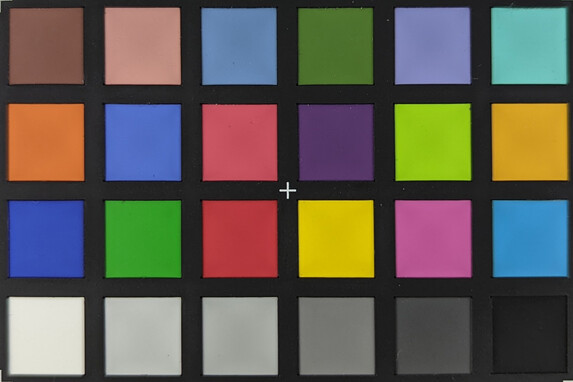

Acessórios e Garantia - Pixel Smartphone sem Carregador
O Google Pixel 6 Pro vem com um cabo USB-C, um dongle USB OTG (USB-C para A), e uma ferramenta SIM. Carregadores compatíveis com fio ou sem fio devem ser adquiridos separadamente.
Ao contrário dos modelos europeus vendidos nos Estados Unidos, as unidades estão limitadas a apenas 12 meses de garantia com extensões de garantia opcionais por até dois anos disponíveis por US$ 199 ou até três anos por uma taxa mensal de US$ 9.
Dispositivos de Entrada e Manuseio - Sem detecção facial
A tela sensível ao toque capacitiva do Google Pixel 6 Pro funcionou sem falhas e se sentiu muito suave. Ela pode detectar até dez entradas simultaneamente e acabou sendo muito precisa no geral. O motor de vibração incorporado era muito firme e nítido.
O dispositivo possui um leitor de impressões digitais que, embora muito rápido, não era particularmente preciso e confiável. A detecção facial não está disponível.
Visor - LTPO OLED com até 120 Hz
O display de 6,7 polegadas funciona com uma resolução QHD+ nativa que não pode ser baixada no software. Além disso, este visor LTPO OLED suporta taxa de atualização adaptável entre 60 e 120 Hz.
A iluminação foi muito uniforme e consistente, e o display atingiu um pico de brilho de 814 lêndeas em uma imagem totalmente branca e até 1.053 lêndeas (centro) em nosso teste APL50 com azulejos preto-e-branco uniformemente distribuídos. Com o sensor de luz ambiente desativado, o brilho máximo é limitado a apenas 489 lêndeas.
A cintilação do PWM foi idêntica à do Pixel 6 com cintilação desigual entre 176,1 e 376,6 Hz com brilho mínimo e uma amplitude mais plana com níveis crescentes de brilho. No entanto, usuários sensíveis podem ter problemas com o dispositivo, especialmente porque o escurecimento DC não é suportado.
| |||||||||||||||||||||||||
iluminação: 97 %
iluminação com acumulador: 794 cd/m²
Contraste: ∞:1 (Preto: 0 cd/m²)
ΔE ColorChecker Calman: 0.9 | ∀{0.5-29.43 Ø4.78}
ΔE Greyscale Calman: 1.5 | ∀{0.09-98 Ø5}
98.5% sRGB (Calman 2D)
Gamma: 2.23
CCT: 6654 K
| Google Pixel 6 Pro LTPO-OLED, 3120x1440, 6.7" | Samsung Galaxy S22+ AMOLED, 2340x1080, 6.6" | Xiaomi 12 Pro AMOLED, 3200x1440, 6.7" | Apple iPhone 13 Pro OLED, 2532x1170, 6.1" | Oppo Find X5 Pro AMOLED, 3216x1440, 6.7" | |
|---|---|---|---|---|---|
| Screen | -38% | -8% | 8% | 1% | |
| Brightness middle (cd/m²) | 794 | 1090 37% | 959 21% | 1050 32% | 746 -6% |
| Brightness (cd/m²) | 801 | 1097 37% | 977 22% | 1058 32% | 744 -7% |
| Brightness Distribution (%) | 97 | 98 1% | 96 -1% | 98 1% | 97 0% |
| Black Level * (cd/m²) | |||||
| Colorchecker dE 2000 * | 0.9 | 2.5 -178% | 1.1 -22% | 1 -11% | 0.9 -0% |
| Colorchecker dE 2000 max. * | 2.2 | 3.8 -73% | 3.1 -41% | 2.4 -9% | 1.6 27% |
| Greyscale dE 2000 * | 1.5 | 2.3 -53% | 1.9 -27% | 1.5 -0% | 1.6 -7% |
| Gamma | 2.23 99% | 2.04 108% | 2.22 99% | 2.2 100% | 2.23 99% |
| CCT | 6654 98% | 6492 100% | 6498 100% | 6504 100% | 6499 100% |
* ... menor é melhor
Cintilação da tela / PWM (modulação por largura de pulso)
| Tela tremeluzindo/PWM detectado | 360.5 Hz | ||
A luz de fundo da tela pisca em 360.5 Hz (pior caso, por exemplo, utilizando PWM) . A frequência de 360.5 Hz é relativamente alta, portanto, a maioria dos usuários sensíveis ao PWM não deve notar nenhuma oscilação. No entanto, há relatos de que alguns usuários ainda são sensíveis ao PWM em 500 Hz e acima, portanto, esteja atento. [pwm_comparison] Em comparação: 53 % de todos os dispositivos testados não usam PWM para escurecer a tela. Se PWM foi detectado, uma média de 8111 (mínimo: 5 - máximo: 343500) Hz foi medida. | |||
Zoom fixo com vários ajustes de brilho
Encontramos o perfil de cor "Natural" para produzir as cores mais precisas. Tenha em mente que ele é limitado ao espaço de cor sRGB menor. Se você quiser usar o maior espaço de cores DCI-P3, você precisa habilitar os modos de cores "Adaptativo" ou "Vívido". Ambos apresentam um equilíbrio de branco muito semelhante com diferentes níveis de saturação
Exibir tempos de resposta
| ↔ Tempo de resposta preto para branco | ||
|---|---|---|
| 1.354 ms ... ascensão ↗ e queda ↘ combinadas | ↗ 0.73 ms ascensão | |
| ↘ 0.624 ms queda | ||
| A tela mostra taxas de resposta muito rápidas em nossos testes e deve ser muito adequada para jogos em ritmo acelerado. Em comparação, todos os dispositivos testados variam de 0.1 (mínimo) a 240 (máximo) ms. » 6 % de todos os dispositivos são melhores. Isso significa que o tempo de resposta medido é melhor que a média de todos os dispositivos testados (20.2 ms). | ||
| ↔ Tempo de resposta 50% cinza a 80% cinza | ||
| 0.692 ms ... ascensão ↗ e queda ↘ combinadas | ↗ 0.346 ms ascensão | |
| ↘ 0.346 ms queda | ||
| A tela mostra taxas de resposta muito rápidas em nossos testes e deve ser muito adequada para jogos em ritmo acelerado. Em comparação, todos os dispositivos testados variam de 0.165 (mínimo) a 636 (máximo) ms. » 2 % de todos os dispositivos são melhores. Isso significa que o tempo de resposta medido é melhor que a média de todos os dispositivos testados (31.6 ms). | ||
A usabilidade no exterior é muito boa em geral, mas não tão boa como com outros dispositivos, como por exemplo o Test Samsung Galaxy S22+ Smartphone - Die große Version des Galaxy S22 Galaxy S22 Plus.
Como esperado, os ângulos de visão são excelentes com apenas uma pequena diminuição no brilho e nenhuma tonalidade de cor visível em ângulos extremos.
Desempenho - Pixel Smartphone com Google SoC
Como seu irmão, o Google Pixel 6 Pro apresenta o próprio Google Tensor SoC. Ele tem acesso a 12 GB de RAM LPDDR5, o chip de segurança Titan M2 e um integrado ARM Mali-G78 MP20 GPU. Esta combinação definitivamente pode ser encontrada no espectro high-end dos dispositivos móveis e deve proporcionar um sistema muito suave e desempenho de jogo.
No geral, o SoC teve um desempenho muito bom, mas acabou sendo incapaz de acompanhar os concorrentes mais recentes. Os SoCs do ano passado, no entanto, são mais propensos a serem concorrentes dignos, com exceção do desempenho de escrita de memória que foi ligeiramente mais lento do que o esperado. Isto, entretanto, não deve fazer nenhuma diferença no uso diário.
| PCMark for Android - Work 3.0 | |
| Samsung Galaxy S22+ | |
| Média da turma Smartphone (4507 - 28557, n=188, últimos 2 anos) | |
| Xiaomi 12 Pro | |
| Oppo Find X5 Pro | |
| Google Pixel 6 Pro | |
| Média Google Tensor (9717 - 11605, n=3) | |
| AImark - Score v2.x | |
| Apple iPhone 13 Pro | |
| Xiaomi 12 Pro | |
| Samsung Galaxy S22+ | |
| Oppo Find X5 Pro | |
| Média Google Tensor (5723 - 5967, n=3) | |
| Google Pixel 6 Pro | |
| UL Procyon AI Inference for Android - Overall Score NNAPI | |
| Oppo Find X5 Pro | |
| Xiaomi 12 Pro | |
| Google Pixel 6 Pro | |
| Média Google Tensor (21639 - 28581, n=3) | |
| Média da turma Smartphone (3769 - 81594, n=139, últimos 2 anos) | |
GFXBench (DX / GLBenchmark) 2.7: T-Rex Onscreen | 1920x1080 T-Rex Offscreen
GFXBench 3.0: on screen Manhattan Onscreen OGL | 1920x1080 1080p Manhattan Offscreen
GFXBench 3.1: on screen Manhattan ES 3.1 Onscreen | 1920x1080 Manhattan ES 3.1 Offscreen
GFXBench: on screen Car Chase Onscreen | 1920x1080 Car Chase Offscreen | on screen Aztec Ruins High Tier Onscreen | 2560x1440 Aztec Ruins High Tier Offscreen | on screen Aztec Ruins Normal Tier Onscreen | 1920x1080 Aztec Ruins Normal Tier Offscreen
| 3DMark / Wild Life Extreme Unlimited | |
| Apple iPhone 13 Pro | |
| Oppo Find X5 Pro | |
| Xiaomi 12 Pro | |
| Google Pixel 6 Pro | |
| Samsung Galaxy S22+ | |
| 3DMark / Wild Life Extreme | |
| Apple iPhone 13 Pro | |
| Xiaomi 12 Pro | |
| Oppo Find X5 Pro | |
| Samsung Galaxy S22+ | |
| Google Pixel 6 Pro | |
| 3DMark / Wild Life Unlimited Score | |
| Apple iPhone 13 Pro | |
| Xiaomi 12 Pro | |
| Oppo Find X5 Pro | |
| Samsung Galaxy S22+ | |
| Google Pixel 6 Pro | |
| 3DMark / Wild Life Score | |
| Xiaomi 12 Pro | |
| Oppo Find X5 Pro | |
| Apple iPhone 13 Pro | |
| Samsung Galaxy S22+ | |
| Google Pixel 6 Pro | |
| 3DMark / Sling Shot Extreme (ES 3.1) Unlimited Physics | |
| Xiaomi 12 Pro | |
| Google Pixel 6 Pro | |
| Samsung Galaxy S22+ | |
| Oppo Find X5 Pro | |
| Apple iPhone 13 Pro | |
| 3DMark / Sling Shot Extreme (ES 3.1) Unlimited Graphics | |
| Oppo Find X5 Pro | |
| Apple iPhone 13 Pro | |
| Samsung Galaxy S22+ | |
| Xiaomi 12 Pro | |
| Google Pixel 6 Pro | |
| 3DMark / Sling Shot Extreme (ES 3.1) Unlimited | |
| Oppo Find X5 Pro | |
| Xiaomi 12 Pro | |
| Samsung Galaxy S22+ | |
| Google Pixel 6 Pro | |
| Apple iPhone 13 Pro | |
| 3DMark / Sling Shot OpenGL ES 3.0 Unlimited | |
| Oppo Find X5 Pro | |
| Samsung Galaxy S22+ | |
| Xiaomi 12 Pro | |
| Google Pixel 6 Pro | |
| Apple iPhone 13 Pro | |
| 3DMark / Sling Shot OpenGL ES 3.0 Unlimited Graphics | |
| Apple iPhone 13 Pro | |
| Oppo Find X5 Pro | |
| Samsung Galaxy S22+ | |
| Xiaomi 12 Pro | |
| Google Pixel 6 Pro | |
| 3DMark / Sling Shot OpenGL ES 3.0 Unlimited Physics | |
| Oppo Find X5 Pro | |
| Google Pixel 6 Pro | |
| Xiaomi 12 Pro | |
| Samsung Galaxy S22+ | |
| Apple iPhone 13 Pro | |
| GFXBench (DX / GLBenchmark) 2.7 / T-Rex Onscreen | |
| Xiaomi 12 Pro | |
| Samsung Galaxy S22+ | |
| Google Pixel 6 Pro | |
| Apple iPhone 13 Pro | |
| Oppo Find X5 Pro | |
| GFXBench (DX / GLBenchmark) 2.7 / T-Rex Offscreen | |
| Xiaomi 12 Pro | |
| Apple iPhone 13 Pro | |
| Oppo Find X5 Pro | |
| Samsung Galaxy S22+ | |
| Google Pixel 6 Pro | |
| GFXBench 3.0 / Manhattan Onscreen OGL | |
| Samsung Galaxy S22+ | |
| Xiaomi 12 Pro | |
| Google Pixel 6 Pro | |
| Apple iPhone 13 Pro | |
| Oppo Find X5 Pro | |
| GFXBench 3.0 / 1080p Manhattan Offscreen | |
| Xiaomi 12 Pro | |
| Apple iPhone 13 Pro | |
| Samsung Galaxy S22+ | |
| Oppo Find X5 Pro | |
| Google Pixel 6 Pro | |
| GFXBench 3.1 / Manhattan ES 3.1 Onscreen | |
| Samsung Galaxy S22+ | |
| Xiaomi 12 Pro | |
| Apple iPhone 13 Pro | |
| Oppo Find X5 Pro | |
| Google Pixel 6 Pro | |
| GFXBench 3.1 / Manhattan ES 3.1 Offscreen | |
| Xiaomi 12 Pro | |
| Apple iPhone 13 Pro | |
| Samsung Galaxy S22+ | |
| Oppo Find X5 Pro | |
| Google Pixel 6 Pro | |
| GFXBench / Car Chase Onscreen | |
| Samsung Galaxy S22+ | |
| Apple iPhone 13 Pro | |
| Oppo Find X5 Pro | |
| Xiaomi 12 Pro | |
| Google Pixel 6 Pro | |
| GFXBench / Car Chase Offscreen | |
| Apple iPhone 13 Pro | |
| Samsung Galaxy S22+ | |
| Xiaomi 12 Pro | |
| Oppo Find X5 Pro | |
| Google Pixel 6 Pro | |
| GFXBench / Aztec Ruins High Tier Onscreen | |
| Apple iPhone 13 Pro | |
| Samsung Galaxy S22+ | |
| Oppo Find X5 Pro | |
| Google Pixel 6 Pro | |
| Xiaomi 12 Pro | |
| GFXBench / Aztec Ruins High Tier Offscreen | |
| Oppo Find X5 Pro | |
| Apple iPhone 13 Pro | |
| Xiaomi 12 Pro | |
| Samsung Galaxy S22+ | |
| Google Pixel 6 Pro | |
| GFXBench / Aztec Ruins Normal Tier Onscreen | |
| Samsung Galaxy S22+ | |
| Apple iPhone 13 Pro | |
| Oppo Find X5 Pro | |
| Xiaomi 12 Pro | |
| Google Pixel 6 Pro | |
| GFXBench / Aztec Ruins Normal Tier Offscreen | |
| Apple iPhone 13 Pro | |
| Oppo Find X5 Pro | |
| Xiaomi 12 Pro | |
| Google Pixel 6 Pro | |
| Samsung Galaxy S22+ | |
| Jetstream 2 - 2.0 Total Score | |
| Apple iPhone 13 Pro (Safari 15) | |
| Média da turma Smartphone (23.8 - 387, n=153, últimos 2 anos) | |
| Samsung Galaxy S22+ (Chrome 100.0.4896.127) | |
| Oppo Find X5 Pro (Chrome 99) | |
| Google Pixel 6 Pro (Chrome 100) | |
| Média Google Tensor (75.3 - 91.7, n=3) | |
| Xiaomi 12 Pro (Chrome 97) | |
| JetStream 1.1 - Total Score | |
| Apple iPhone 13 Pro (Safari 15) | |
| Google Pixel 6 Pro (Chrome 100) | |
| Média Google Tensor (180.4 - 189.6, n=2) | |
| Oppo Find X5 Pro (Chrome 99) | |
| Xiaomi 12 Pro (Chrome 97) | |
| Samsung Galaxy S22+ (Chrome 100.0.4896.127) | |
| Speedometer 2.0 - Result 2.0 | |
| Apple iPhone 13 Pro (Safari 15) | |
| Média da turma Smartphone (15.2 - 643, n=128, últimos 2 anos) | |
| Google Pixel 6 Pro (Chrome 100) | |
| Samsung Galaxy S22+ (Chrome 100.0.4896.127) | |
| Oppo Find X5 Pro (Chrome 99) | |
| Média Google Tensor (90.4 - 111, n=3) | |
| Xiaomi 12 Pro (Chrome 97) | |
| WebXPRT 3 - Overall | |
| Apple iPhone 13 Pro (Safari 15) | |
| Média da turma Smartphone (38 - 380, n=35, últimos 2 anos) | |
| Samsung Galaxy S22+ (Chrome 100.0.4896.127) | |
| Oppo Find X5 Pro (Chrome 99) | |
| Xiaomi 12 Pro (Chrome 97) | |
| Google Pixel 6 Pro (Chrome 100) | |
| Média Google Tensor (77 - 110, n=3) | |
| Octane V2 - Total Score | |
| Apple iPhone 13 Pro (Safari 15) | |
| Média da turma Smartphone (2228 - 121337, n=201, últimos 2 anos) | |
| Samsung Galaxy S22+ (Chrome 100.0.4896.127) | |
| Google Pixel 6 Pro (Chrome 100) | |
| Média Google Tensor (33046 - 44034, n=3) | |
| Oppo Find X5 Pro (Chrome 99) | |
| Xiaomi 12 Pro (Chrome 97) | |
| Mozilla Kraken 1.1 - Total | |
| Samsung Galaxy S22+ (Chrome 100.0.4896.127) | |
| Xiaomi 12 Pro (Chrome 97) | |
| Média Google Tensor (915 - 1532, n=3) | |
| Média da turma Smartphone (257 - 28190, n=156, últimos 2 anos) | |
| Oppo Find X5 Pro (Chrome 99) | |
| Google Pixel 6 Pro (Chrome 100) | |
| Apple iPhone 13 Pro (Safari 15) | |
* ... menor é melhor
| Google Pixel 6 Pro | Samsung Galaxy S22+ | Xiaomi 12 Pro | Oppo Find X5 Pro | Google Pixel 5 | Média 128 GB UFS 3.1 Flash | Média da turma Smartphone | |
|---|---|---|---|---|---|---|---|
| AndroBench 3-5 | 130% | 203% | 80% | -18% | 85% | 229% | |
| Sequential Read 256KB (MB/s) | 1560 | 1629.99 4% | 1620 4% | 1410 -10% | 851 -45% | 1586 ? 2% | 2223 ? 43% |
| Sequential Write 256KB (MB/s) | 242.5 | 1001.67 313% | 1465 504% | 894 269% | 190 -22% | 763 ? 215% | 1838 ? 658% |
| Random Read 4KB (MB/s) | 129.4 | 306.7 137% | 324.9 151% | 183.7 42% | 138.9 7% | 243 ? 88% | 295 ? 128% |
| Random Write 4KB (MB/s) | 178.5 | 297.67 67% | 448.9 151% | 210.4 18% | 155.9 -13% | 241 ? 35% | 335 ? 88% |
Emissões - Tensor Google com explosão de desempenho a curto prazo
Temperatura
Quando ocioso, o Google Pixel 6 Pro permaneceu na maioria das vezes frio e mesmo sob carga ele só aqueceu levemente e seletivamente.
Dentro de sua casca fria, no entanto, as coisas são um pouco diferentes. Ao executar o teste de estresse 3DMark Wild Life do Google Tensor Soc sofreu imensamente e teve que acelerar termicamente seu desempenho em até 56%. No entanto, o Google Pixel 6 Pro está em muito boa companhia, pois foi muito semelhante ao da Samsung Samsung Galaxy Revisão S21 FE 5G: O smartphone de edição em ventilador vai para a próxima rodadaGalaxy S21 FE's Snapdragon 888.
(+) A temperatura máxima no lado superior é 37.3 °C / 99 F, em comparação com a média de 35.2 °C / 95 F , variando de 21.9 a 247 °C para a classe Smartphone.
(+) A parte inferior aquece até um máximo de 36 °C / 97 F, em comparação com a média de 34 °C / 93 F
(+) Em uso inativo, a temperatura média para o lado superior é 25.3 °C / 78 F, em comparação com a média do dispositivo de 32.9 °C / ### class_avg_f### F.
3DMark Wild Life Stress Test
| 3DMark | |
| Wild Life Stress Test Stability | |
| Apple iPhone 13 Pro | |
| Oppo Find X5 Pro | |
| Samsung Galaxy S22+ | |
| Xiaomi 12 Pro | |
| Google Pixel 6 Pro | |
| Wild Life Extreme Stress Test | |
| Apple iPhone 13 Pro | |
| Oppo Find X5 Pro | |
| Samsung Galaxy S22+ | |
| Google Pixel 6 Pro | |
| Xiaomi 12 Pro | |
Orador
Os dois alto-falantes do Google Pixel 6 Pro tiveram um desempenho relativamente bom em geral, com uma falta de graves que se tornaram mais pronunciados e perceptíveis apenas em alto volume.
A saída de som com fio é suportada apenas via USB-C, e um dongle compatível não está incluído e tem que ser adquirido separadamente. A saída de áudio Bluetooth sem fio suporta áudio de alta definição via SBC, AAC, aptX, aptX HD, e LDAC.
Google Pixel 6 Pro análise de áudio
(+) | os alto-falantes podem tocar relativamente alto (###valor### dB)
Graves 100 - 315Hz
(-) | quase nenhum baixo - em média 18.5% menor que a mediana
(±) | a linearidade dos graves é média (12% delta para a frequência anterior)
Médios 400 - 2.000 Hz
(+) | médios equilibrados - apenas 4.4% longe da mediana
(+) | médios são lineares (6.5% delta para frequência anterior)
Altos 2 - 16 kHz
(±) | máximos mais altos - em média 6.2% maior que a mediana
(±) | a linearidade dos máximos é média (8.6% delta para frequência anterior)
Geral 100 - 16.000 Hz
(±) | a linearidade do som geral é média (16.8% diferença em relação à mediana)
Comparado com a mesma classe
» 8% de todos os dispositivos testados nesta classe foram melhores, 7% semelhantes, 85% piores
» O melhor teve um delta de 11%, a média foi 35%, o pior foi 134%
Comparado com todos os dispositivos testados
» 29% de todos os dispositivos testados foram melhores, 7% semelhantes, 64% piores
» O melhor teve um delta de 4%, a média foi 24%, o pior foi 134%
Samsung Galaxy S22+ análise de áudio
(+) | os alto-falantes podem tocar relativamente alto (###valor### dB)
Graves 100 - 315Hz
(-) | quase nenhum baixo - em média 23.2% menor que a mediana
(±) | a linearidade dos graves é média (7.1% delta para a frequência anterior)
Médios 400 - 2.000 Hz
(±) | médios mais altos - em média 5.5% maior que a mediana
(+) | médios são lineares (4.5% delta para frequência anterior)
Altos 2 - 16 kHz
(±) | máximos mais altos - em média 5.8% maior que a mediana
(+) | os máximos são lineares (6.1% delta da frequência anterior)
Geral 100 - 16.000 Hz
(±) | a linearidade do som geral é média (18% diferença em relação à mediana)
Comparado com a mesma classe
» 16% de todos os dispositivos testados nesta classe foram melhores, 8% semelhantes, 76% piores
» O melhor teve um delta de 11%, a média foi 35%, o pior foi 134%
Comparado com todos os dispositivos testados
» 37% de todos os dispositivos testados foram melhores, 8% semelhantes, 55% piores
» O melhor teve um delta de 4%, a média foi 24%, o pior foi 134%
Gerenciamento de energia - Pixel 6 Pro com mais de 5.000 mAh
Consumo de energia
Em nossos testes, o consumo de energia do Google Pixel 6 Pro se revelou discreto e bastante baixo em geral.
Sua bateria de 5.003 mAh suporta carga com fio de até 30 W, com a fonte de alimentação opcional de 29 W disponível no Google. As fontes de alimentação de terceiros terão que suportar USB-PD 3.0 para permitir um carregamento rápido.
Alternativamente, o Pixel 6 Pro também pode ser carregado sem fio. O opcional Google Pixel Stand 2 carrega com até 23 W. Outras fontes de alimentação EPP certificadas Qi estão limitadas a apenas 12 W. Os dispositivos suportam carga reversa sem fio.
| desligado | |
| Ocioso | |
| Carga |
|
Key:
min: | |
| Google Pixel 6 Pro 5003 mAh | Samsung Galaxy S22+ 4500 mAh | Xiaomi 12 Pro 4600 mAh | Apple iPhone 13 Pro 3095 mAh | Oppo Find X5 Pro 5000 mAh | Média Google Tensor | Média da turma Smartphone | |
|---|---|---|---|---|---|---|---|
| Power Consumption | -7% | -10% | 6% | -15% | -3% | -27% | |
| Idle Minimum * (Watt) | 0.7 | 0.71 -1% | 0.94 -34% | 0.51 27% | 1.24 -77% | 0.687 ? 2% | 0.848 ? -21% |
| Idle Average * (Watt) | 1 | 1.1 -10% | 1.24 -24% | 1.54 -54% | 1.39 -39% | 1.187 ? -19% | 1.434 ? -43% |
| Idle Maximum * (Watt) | 1.04 | 1.19 -14% | 1.34 -29% | 1.57 -51% | 1.42 -37% | 1.213 ? -17% | 1.618 ? -56% |
| Load Average * (Watt) | 6.87 | 7.74 -13% | 5.7 17% | 3.06 55% | 3.58 48% | 5.88 ? 14% | 7.01 ? -2% |
| Load Maximum * (Watt) | 9.87 | 9.64 2% | 8.12 18% | 4.59 53% | 6.99 29% | 9.2 ? 7% | 11.3 ? -14% |
* ... menor é melhor
Power Consumption: Geekbench (150 cd/m²)
Power Consumption: GFXBench (150 cd/m²)
Vida útil da bateria
Apesar de sua grande bateria, o Pixel 6 Pro teve um desempenho quase idêntico ao do Pixel 6 com sua bateria muito menor de 4.614 mAh em nossos testes. Outras melhorias teriam sido possíveis, por exemplo, suportando uma taxa de atualização do display mais moderna e flexível.
Tudo considerado, o dispositivo deveria passar facilmente por um longo dia.
| Google Pixel 6 Pro 5003 mAh | Samsung Galaxy S21 FE 5G 4500 mAh | Xiaomi 12 Pro 4600 mAh | Apple iPhone 13 Pro 3095 mAh | Oppo Find X5 Pro 5000 mAh | |
|---|---|---|---|---|---|
| Duração da bateria | -11% | 15% | 50% | 18% | |
| WiFi v1.3 (h) | 11.1 | 9.9 -11% | 12.8 15% | 16.6 50% | 13.1 18% |
| Reader / Idle (h) | 23.8 | 33.9 | 43.6 | 21.2 | |
| H.264 (h) | 15.6 | 13.1 | 24.9 | 19 | |
| Load (h) | 6.5 | 5.6 | 5.6 | 6.1 |
Pro
Contra
Veredicto - Dispositivo Poderoso
O Google Pixel 6 Pro melhora o mais acessível Pixel 6 de várias maneiras. Sua tela arredondada significa que é mais confortável de segurar na mão, e você mal pode notar seu tamanho aumentado. A maior taxa de atualização de 120 Hz significa que ele tem uma aparência e toque mais suave. O conjunto de câmeras melhorado vem não apenas com uma lente teleobjectiva na parte traseira, mas também com uma câmera frontal de maior resolução.
Carregamento sem fio e sem fio reverso, certificação IP68 contra entrada de poeira e água, Wi-Fi rápido e conectividade 5G moderna completam o pacote, e mesmo a SKU mais espaçosa vem com um MSRP de apenas um pouco mais de $1.000.
O Google Pixel 6 Pro é um poderoso smartphone topo de gama com puro Android e uma boa matriz de três câmeras.
Em comparação com seus concorrentes mais caros, o Google Pixel 6 Pro sofre de algumas falhas. Por exemplo, sua porta USB 3.2 não carrega um sinal de saída do display, e seu display adaptável suporta apenas 60 ou 120 Hz. A vida útil da bateria certamente teria se beneficiado de uma abordagem mais flexível. Seu suporte a Wi-Fi 6E revelou-se muito deficiente e pouco confiável em nossos testes. O ciclo de atualização do Pixel 6 Pro é muito longo, mas já tivemos problemas com a distribuição de atualizações e atrasos no passado. Tendo dito que a atualização de abril mais atual chegou a tempo e não causou nenhum problema.
Se você quiser um longo ciclo de atualização, você também pode dar uma olhada mais de perto na série S22 de smartphones da Samsung Galaxy que promete uma atualização adicional de recursos sobre a série Pixel 6 do Google. Outros poderosos Android smartphones incluem o
e
embora estes venham a um preço mais alto e não estejam disponíveis em todos os mercados.
Preço e Disponibilidade
Google Pixel 6 Pro
- 08/30/2022 v7 (old)
Daniel Schmidt




